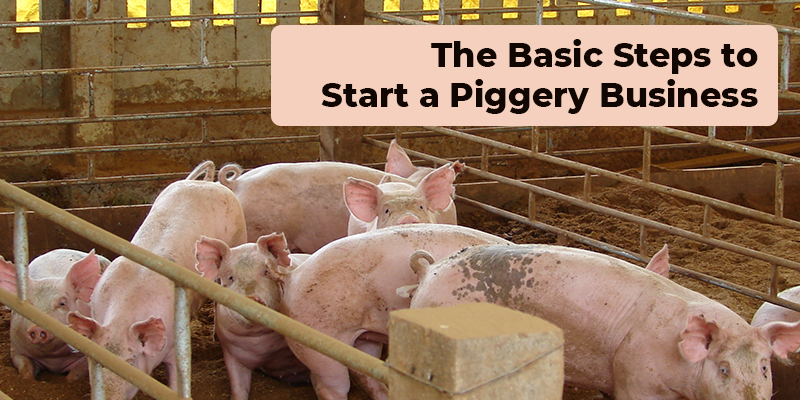The meat and poultry industry is one of the biggest and profitable industries of the world due to the simple fact that the demand for the same is always high. Now, if we talk about the most widely consumed meat in the world, it is the pork meat or pig meat, and this is the reason pig farming is preferred by most of the people who are looking to enter into the animal business.
The main focus of this farming practice is to raise, breed, and sell pigs. Pigs are considered to be highly proficient feed converters after the chicken. In India, this farming has been mostly practiced by socially backward classes since ages since they do not really have other occupational options fetching the same amount of revenue.
What makes Pig Farming Profitable?
The following explanation clearly tells us why exactly this business is so profitable and what makes everyone prefer it over other options:
- Pigs grow quicker than other animals and take minimal time to get sold in the market as mature pigs.
- Pig meat is nutritious and tasty food consumed globally, and the demand for the same is becoming more and more.
- Producing and exporting to foreign countries is not just limited to fresh meat but includes ham, lard, pork, bacon, sausages, and more.
- Pigs consume every type of feed like garbage, grains, forage, fruits, sugarcane, vegetables, damaged food, etc., reducing food concern a lot while raising them.
- The investment cost is usually low and is mainly focused on buying equipment and building shelter houses.
- The feed conversion efficiency of pigs is relatively higher, making the feed to the meat converting ratio extremely high.
- The demand for pig fat is huge in chemical and soap industries, paints, and poultry feed.
- Lastly, a business of pig farming ensures a high break even and ROI (return on investment) ratio.
The 8 Step Guide to Piggery Farming
Step 1: Receive Training to Raise Pigs
Before you start the commercial piggery business, it is essential to go through proper training for raising the pigs from established training centres and universities. The main objective of this training will be to:
- Help you understand the nuances of this business.
- Let you know in which type of environment you should raise pigs for their welfare enhancement.
- Enable you to form working relationships with managers and industry people.
- Help you increase production health and efficiency, along with your firm’s economic viability.
Step 2: Select an Appropriate Land
After you have gained sufficient knowledge regarding the raising of pigs, the next step is to select an appropriate land for the same. This should be based on the availability of essential facilities for pigs’ raising, as described below:
- A sufficient amount of fresh and clean and fresh water.
- A noise-free and calm area.
- Market proximity to buy essential medications, vaccines, commodities, and sell farm products.
- Preferably a rural land, owing to the easy and cheap availability of labours.
- A superior browsing place.
- A superior market transportation system.
- The provision of veterinary service.
Step 3: Obtain Productive Pig Breeds
After setting up your farm successfully, it is time to obtain pig breeds. There are multiple pig breeds that are available in the worldwide market and you must select the breeds that are high in terms of commercial profitability.
The widely acquired pig breeds for commercial pig production are the Hampshire, Landrace, Duroc, Yorkshire, and their crosses. These breeds are highly capable of producing lean meat and also have a proficient feed conversion. Apart from this, as compared to local pig breeds, such commercial breeds are disease-resistant and are affected more from low quality feeds and hot weather.
Step 4: Start the Pig Housing Process
It is imperative to construct comfortable houses for pigs comprising essential equipment as this has a huge role to play in making your pig farming business a true success. These houses will not only provide shelter to your pigs but also keep the numerous pig diseases, parasites, and predators at bay.
Also, apart from the essential requirements, make sure that these houses have a proper ventilation system in place to keep the weaner, farrowing, dry sow, and boar separate. This is due to the fact that for each pig type, there is a dissimilar space requirement.
Step 5: Feed the Pigs Efficiently
Feeding pigs efficiently is a vital aspect of commercial farming. The overall growth ratio and pig health are highly dependent on the food’s nutritional level. The basic pig feed ingredients include oats, wheat, rice, grains, sorghum, maize, and other millets.
Ensure adding a few protein supplements such as meat and fish meal, oil cakes, etc. Apart from this, make water available in abundance since a pig needs it daily, which accounts to 1.5-2 gallons of water/6 months approximately.
Step 6: Initiate the Breeding Process
The breeding process of pigs is pretty simple and easy. Under normal circumstances, within the age of 8 months, both female and male pigs become ready for breeding and usually weigh 100-120 kg.
The heat period ranges from 2-3 days for female pigs, with the first and second day considered the best to breed and sow, respectively. After 2-10 days of weaning, a sow is ready to breed again.
115 days is considered as the upper limit for the pigs’ gestation period. A sow is capable of giving birth to piglets two times a year comprising about 8-12 piglets every time.
Step 7: Ensure Proper Care and Management
It is your duty to ensure proper care of your animals and keep them safe against various diseases and health hazards. Also, some of the male pigs can be castrated when they become 3-4 weeks old. You must feed nutritious feed to the sow, especially during the lactation time and carefully breed piglets, boar, and other sows that are pregnant.
To keep swine fever at bay, make sure that you provide vaccination to the piglets within 2-4 weeks of age. Apart from this, do not allow visitors to roam around in the farm unnecessarily to keep pigs safe.
Step 8: Focus on Marketing Your Products
This goes for all the businesses and not just the pig farming business. When pigs reach their slaughtering age, you can easily sell them in the local and international markets since there is a lot of demand for the same. However, the problem persists when you have to compete with other farming business owners. This is where marketing steps in.
If you will have a proper marketing campaign in place that focuses on promoting the quality of your products and health safety measures being adopted while raising pigs, you will not only have more clients in the local and national market but in the international market as well.
We hope now you have got an in-depth understanding of the pig farming business in India and how to establish the same in the best possible manner. The step-by-step guide mentioned above will help you in taking care of every process that is essential for the success of your business. However, as a newcomer in this business, you may have a lot of speculations in mind regarding pig breed and other issues related to animal farming.
Do not worry! Here is a solution for you. Visit the Apni Kheti website or download the app for seeking valuable information regarding the same. Also, their experts are available to address any of your farming concerns since the Apni Kheti platform is built exclusively to help the rural and farming community of India. Get in touch with the experts today itself!
For more information about Agriculture and Livestock, download Apni Kheti app – Android, iPhone





